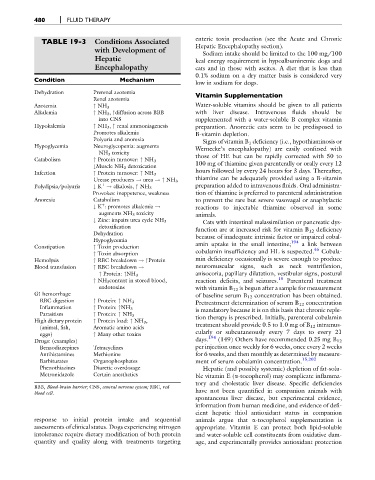Page 492 - Fluid, Electrolyte, and Acid-Base Disorders in Small Animal Practice
P. 492
480 FLUID THERAPY
TABLE 19-3 Conditions Associated enteric toxin production (see the Acute and Chronic
with Development of Hepatic Encephalopathy section).
Sodium intake should be limited to the 100 mg/100
Hepatic kcal energy requirement in hypoalbuminemic dogs and
Encephalopathy cats and in those with ascites. A diet that is less than
0.1% sodium on a dry matter basis is considered very
Condition Mechanism
low in sodium for dogs.
Dehydration Prerenal azotemia Vitamin Supplementation
Renal azotemia
Azotemia " NH 3 Water-soluble vitamins should be given to all patients
Alkalemia " NH 3 , "diffusion across BBB with liver disease. Intravenous fluids should be
into CNS supplemented with a water-soluble B complex vitamin
Hypokalemia " NH 3 , " renal ammoniagenesis preparation. Anorectic cats seem to be predisposed to
Promotes alkalemia B-vitamin depletion.
Polyuria and anorexia
Signs of vitamin B 1 deficiency (i.e., hypothiaminosis or
Hypoglycemia Neuroglycopenia: augments
Wernecke’s encephalopathy) are easily confused with
NH 3 toxicity
those of HE but can be rapidly corrected with 50 to
Catabolism " Protein turnover: " NH 3
100 mg of thiamine given parenterally or orally every 12
#Muscle NH 3 detoxication
Infection " Protein turnover: " NH 3 hours followed by every 24 hours for 3 days. Thereafter,
thiamine can be adequately provided using a B-vitamin
Urease producers ! urea !" NH 3
þ
Polydipsia/polyuria # K ! alkalosis, " NH 3 preparation added to intravenous fluids. Oral administra-
Provokes: inappetence, weakness tion of thiamine is preferred to parenteral administration
Anorexia Catabolism to prevent the rare but severe vasovagal or anaphylactic
þ
# K : promotes alkalemia ! reactions to injectable thiamine observed in some
augments NH 3 toxicity animals.
Cats with intestinal malassimilation or pancreatic dys-
# Zinc: impairs urea cycle NH 3
detoxification function are at increased risk for vitamin B 12 deficiency
Dehydration because of inadequate intrinsic factor or impaired cobal-
Hypoglycemia 194
Constipation " Toxin production amin uptake in the small intestine; a link between
46
cobalamin insufficiency and HL is suspected. Cobala-
" Toxin absorption
Hemolysis " RBC breakdown !"Protein min deficiency occasionally is severe enough to produce
Blood transfusion " RBC breakdown ! neuromuscular signs, such as neck ventriflexion,
anisocoria, papillary dilatation, vestibular signs, postural
" Protein: "NH 3
" NH 3 content in stored blood, reaction deficits, and seizures. 15 Parenteral treatment
endotoxins with vitamin B 12 is begun after a sample for measurement
GI hemorrhage of baseline serum B 12 concentration has been obtained.
RBC digestion " Protein: " NH 3
Pretreatment determination of serum B 12 concentration
Inflammation " Protein: "NH 3
is mandatory because it is on this basis that chronic reple-
Parasitism " Protein: " NH 3
tion therapy is prescribed. Initially, parenteral cobalamin
High dietary protein " Protein load: " NH 3 ,
treatment should provide 0.5 to 1.0 mg of B 12 intramus-
(animal, fish, Aromatic amino acids
eggs) " Many other toxins cularly or subcutaneously every 7 days to every 21
194
Drugs: (examples) days. (149) Others have recommended 0.25 mg B 12
Benzodiazepines Tetracyclines per injection once weekly for 6 weeks, once every 2 weeks
Antihistamines Methionine for 6 weeks, and then monthly as determined by measure-
Barbiturates Organophosphates ment of serum cobalamin concentration. 15,202
Phenothiazines Diuretic overdosage Hepatic (and possibly systemic) depletion of fat-solu-
Metronidazole Certain anesthetics ble vitamin E (a-tocopherol) may complicate inflamma-
tory and cholestatic liver disease. Specific deficiencies
BBB, Blood-brain barrier; CNS, central nervous system; RBC, red
blood cell. have not been quantified in companion animals with
spontaneous liver disease, but experimental evidence,
information from human medicine, and evidence of defi-
cient hepatic thiol antioxidant status in companion
response to initial protein intake and sequential animals argue that a-tocopherol supplementation is
assessments of clinical status. Dogs experiencing nitrogen appropriate. Vitamin E can protect both lipid-soluble
intolerance require dietary modification of both protein and water-soluble cell constituents from oxidative dam-
quantity and quality along with treatments targeting age, and experimentally provides antioxidant protection

